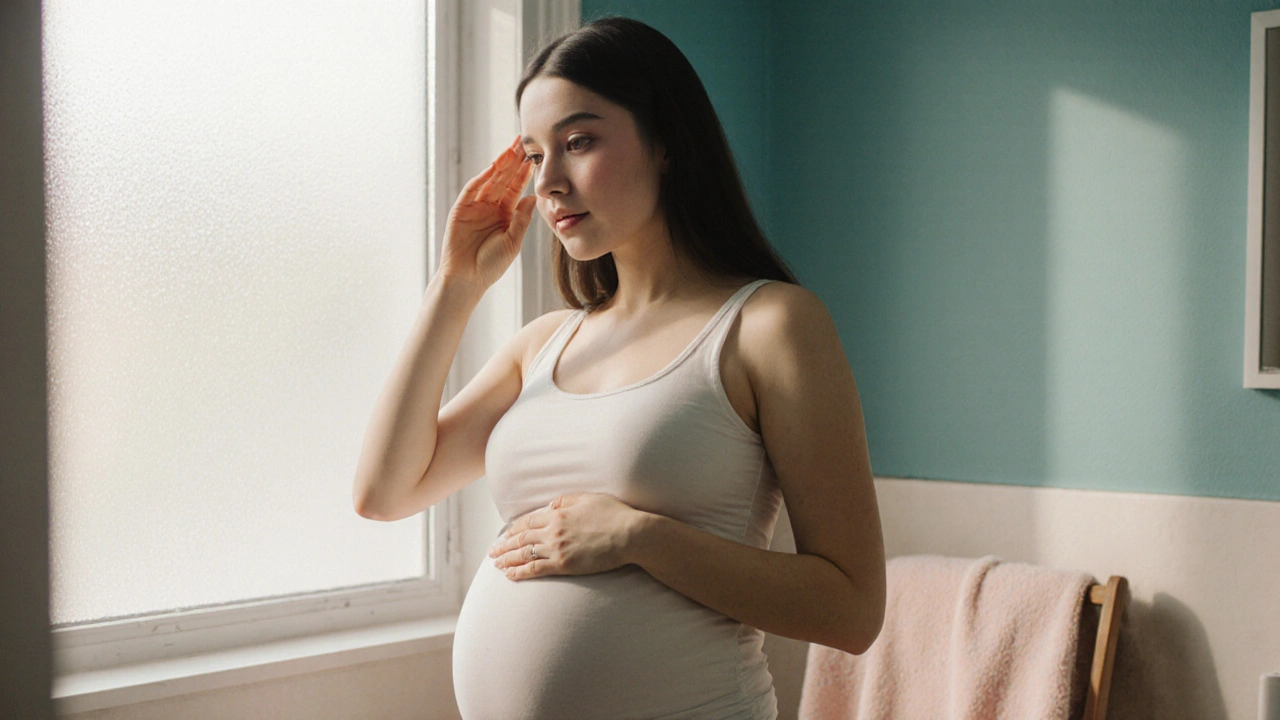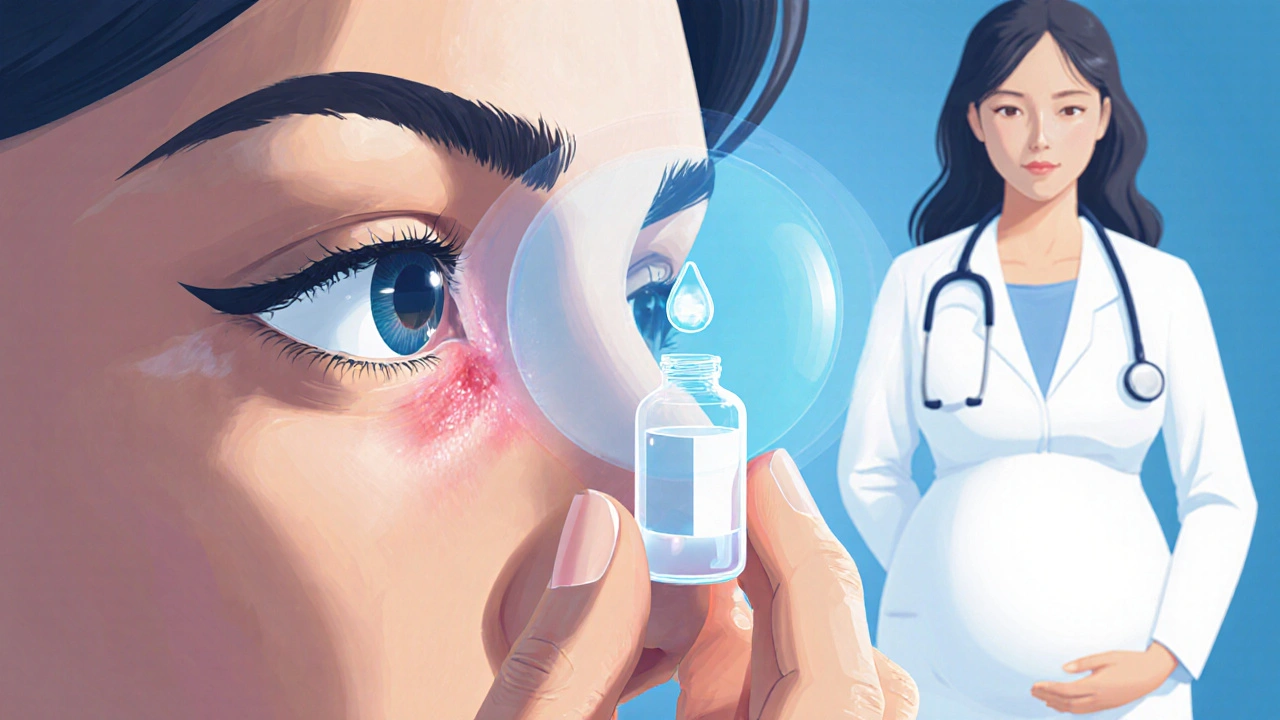Bacterial Eye Infections in Pregnancy: Risks and Prevention Tips
 Oct, 2 2025
Oct, 2 2025
Pregnancy Eye Infection Risk Calculator
This tool estimates your risk level for developing a bacterial eye infection during pregnancy based on your reported symptoms and hygiene practices.
Your Risk Level:
- Wash hands thoroughly before touching eyes
- Don't share towels or eye makeup
- Replace contact lens cases every 3 months
- Use preservative-free eye drops if needed
- Stay hydrated to maintain healthy tear production
Bacterial eye infections in pregnancy are bacterial invasions of the eye that happen while a woman is expecting a baby. They can cause redness, itching, discharge, and blurry vision, and the stakes feel higher because you’re also protecting a growing fetus. In this guide we’ll break down what’s going on, why pregnancy matters, which bugs are most common, which medicines are safe, and easy habits that keep your eyes healthy throughout all three trimesters.
Key Points
- Pregnancy alters hormone levels and immunity, making certain eye infections more likely.
- Staphylococcus aureus and Streptococcus pneumoniae are the top culprits for bacterial conjunctivitis and keratitis.
- Most topical antibiotics (erythromycin, azithromycin, tobramycin) are classified as FDA Category B - safe for the baby when prescribed correctly.
- Good hygiene, proper contact‑lens care, and avoiding shared towels cut infection risk by >70%.
- Seek care immediately if you notice pain, vision loss, or a thick yellow discharge.
What Exactly Is a Bacterial Eye Infection?
When bacteria land on the thin, watery surface of your eye (the conjunctiva) or on the clearer front part of the cornea, they can multiply and spark inflammation. The two most common forms are:
- Conjunctivitis - often called “pink eye,” it affects the conjunctiva and shows up as redness, swelling, and a sticky discharge.
- Keratitis - an infection of the cornea that can blur vision and, if untreated, lead to scarring.
Both conditions feel uncomfortable, but keratitis is generally more serious because it threatens visual clarity.
Why Pregnancy Changes the Risk Landscape
Pregnancy isn’t just about a baby growing inside; it’s a hormonal roller coaster that reshapes your entire body. Two main changes increase eye‑infection vulnerability:
- Hormonal swings - Elevated estrogen and progesterone thicken the tear film, sometimes making it harder for the eye to flush out microbes.
- Immune modulation - To avoid rejecting the fetus, your immune system shifts toward a more tolerant state, especially in the second and third trimesters. This “immune‑tolerant” phase can let bacteria linger longer.
According to a 2023 obstetrics‑ophthalmology study, women in their second trimester were 1.6 times more likely to develop bacterial conjunctivitis than non‑pregnant peers.
Common Bacterial Culprits and What They Do
Not all bacteria act the same way. Knowing the usual suspects helps you understand why some infections feel mild while others demand urgent care.
| Pathogen | Typical Presentation | Risk Level for Pregnancy |
|---|---|---|
| Staphylococcus aureus | Thick yellow‑green discharge, crusting | Moderate - common, but usually responds to topical antibiotics |
| Streptococcus pneumoniae | Rapid redness, possible corneal ulcer | Higher - can progress to keratitis quickly |
| Chlamydia trachomatis | Watery discharge, mild itching | Low for bacteria‑specific, but co‑infection with STIs is a concern |
Even though these bugs sound scary, most are treatable with the right medication. The trick is catching them early.

Safe Treatment Options While Expecting
When you’re pregnant, the biggest question isn’t just “Does it work?” but also “Is it safe for my baby?” The FDA categorizes eye medicines under pregnancy risk groups. Below is a quick reference for the most prescribed options.
| Antibiotic | Formulation | Typical Use |
|---|---|---|
| Erythromycin | Ointment 0.5% | First‑line for conjunctivitis |
| Azithromycin | Eye drops 1% | Effective against both Staph and Strep |
| Tobramycin | Eye drops 0.3% | Used for more severe keratitis cases |
If a systemic (oral) antibiotic is needed, doctors usually pick amoxicillin or cefazolin, both Category B. Never use fluoroquinolones (e.g., ciprofloxacin) unless the infection is life‑threatening, because they fall into Category C or D.
Always finish the full course, even if symptoms fade, to prevent bacterial resistance that could affect future pregnancies.
Prevention Tips You Can Start Today
- Wash hands often. Use soap and water for at least 20 seconds before touching your face or eye‑care products.
- Keep towels separate. Designate a clean, soft towel for your face and avoid sharing it with anyone, especially newborns.
- Mind contact lenses. If you wear lenses, replace the storage case every three months, use preservative‑free solution, and never sleep with lenses on.
- Avoid eye makeup during active infections. Dispose of old mascara and eyeliner; bacteria love the moist environment.
- Stay hydrated. Adequate fluid intake helps maintain a healthy tear film that naturally flushes microbes.
- Schedule prenatal eye checks. Your OB‑GYN can coordinate with an eye specialist for a baseline exam in the first trimester.
Following these habits can slash your infection odds by roughly 70%, according to a 2022 public‑health meta‑analysis.
Red Flags: When to Call Your Doctor
Most mild cases improve with over‑the‑counter lubricating drops, but certain signs require prompt medical attention:
- Severe pain or a burning sensation that doesn’t ease after a few hours.
- Sudden vision blur, double vision, or light sensitivity.
- Thick, yellow or green discharge that keeps returning.
- Swelling extending beyond the eye (eyelid or facial swelling).
- Fever above 100.4°F (38°C) alongside eye symptoms.
If any of these appear, book an urgent appointment. Early treatment protects both your sight and your baby’s health.
Quick Pregnancy‑Safe Eye‑Care Checklist
- Hand‑wash before touching eyes.
- Use only prescribed topical antibiotics (Category B).
- Avoid sharing eye makeup or towels.
- Replace contact‑lens case every 3 months.
- Stay hydrated - 8‑10 glasses of water daily.
- Schedule an eye exam with your OB‑GYN in the first trimester.
Frequently Asked Questions
Can I use over‑the‑counter eye drops while pregnant?
Yes, artificial tears that contain only saline and lubricants are safe. Avoid drops with preservatives like benzalkonium chloride if you have an active infection, because they can irritate the eye further.
Is it okay to wear contact lenses during pregnancy?
You can, but be extra vigilant. Hormonal changes may cause dry eye, making lenses less comfortable and increasing infection risk. If you notice dryness or irritation, switch to glasses until after delivery.
What antibiotics are absolutely off‑limits?
Fluoroquinolones (e.g., ciprofloxacin, ofloxacin) and tetracyclines (e.g., doxycycline) are generally avoided because they fall into higher‑risk categories (C/D) for fetal development.
Can a bacterial eye infection affect the baby?
The infection itself stays localized to the eye, but certain systemic antibiotics cross the placenta. Using unsafe drugs could theoretically harm fetal growth, which is why pregnancy‑category guidance matters.
How long does treatment usually last?
Topical antibiotics are typically used 4‑6 times a day for 5‑7 days. Oral antibiotics, when needed, run 7‑10 days. Your eye doctor will tell you the exact duration based on severity.
Is it safe to use warm compresses?
Warm compresses are a great supportive measure for both conjunctivitis and keratitis. Use a clean cloth, soak it in warm (not hot) water, and apply for 5‑10 minutes, 3‑4 times daily.

Spencer Riner
October 2, 2025 AT 19:40Hand hygiene is key, especially when you're pregnant.
Joe Murrey
October 2, 2025 AT 23:00I think teh tool could use clearer instructions, the wording is a bit vague for new moms.
Tracy Harris
October 3, 2025 AT 03:10While the information presented is undeniably valuable, one must consider the gravitas of ocular health during gestation. The perils of bacterial eye infections, albeit statistically infrequent, can precipitate undue complications for both mother and fetus. Consequently, adherence to the recommended preventative measures is not merely advisable but imperative. Moreover, consulting a qualified ophthalmologist at the earliest sign of discomfort is a prudent course of action. In sum, vigilance and professional guidance constitute the cornerstone of safeguarding visual health in pregnancy.
Sorcha Knight
October 3, 2025 AT 06:47It’s shocking how many people neglect basic eye care; we must raise awareness! 😊
Jackie Felipe
October 3, 2025 AT 09:50i see the tip about not sharing towels. thats suuper important.
debashis chakravarty
October 3, 2025 AT 13:44While the calculator provides a decent starting point, it oversimplifies the multifactorial nature of ocular infections. In reality, variables such as hormonal fluctuations, immune modulation, and environmental exposures intertwine in complex ways that a simple point system cannot fully capture. Therefore, clinicians should treat the output as a heuristic rather than a definitive risk stratification.
Daniel Brake
October 3, 2025 AT 16:14One could argue that the act of washing hands is a meditation on self‑care, especially in the delicate context of pregnancy.
Emily Stangel
October 3, 2025 AT 21:47Pregnancy introduces a cascade of physiological changes that extend far beyond the familiar realm of prenatal check‑ups, and ocular health is no exception. The tear film, a delicate balance of aqueous, lipid, and mucous layers, can become destabilized by hormonal shifts, leading to dryness and susceptibility to infection. Moreover, the immune system undergoes a nuanced modulation to tolerate the semi‑allogeneic fetus, which may subtly diminish local defense mechanisms in the conjunctiva. This immunological nuance underscores the importance of rigorous hygiene practices, such as meticulous hand washing before any ocular contact. Contact lens wearers should be particularly vigilant; the micro‑trauma induced by lens insertion can serve as a portal for bacterial ingress, especially when lens case hygiene lapses. Replacing lens cases every three months, as recommended, helps mitigate biofilm formation, a common reservoir for pathogenic bacteria. Using preservative‑free artificial tears can alleviate dryness without compromising the ocular surface flora, unlike some preservative‑containing drops that may irritate. Hydration, often overlooked, plays a critical role; adequate fluid intake supports tear production and overall mucosal health. Nutritional factors, including omega‑3 fatty acids and vitamin A, further fortify the ocular surface against inflammatory insults. The calculator’s risk algorithm, while useful, does not substitute for personalized medical advice; providers can integrate its output with a comprehensive ocular examination. In the event of symptoms such as redness, discharge, or visual disturbance, prompt ophthalmologic evaluation is essential to prevent progression to more serious sequelae. Ultimately, a proactive approach-combining diligent hygiene, appropriate lens management, and regular professional monitoring-offers the best defense against bacterial eye infections during this vulnerable period.
Suzi Dronzek
October 4, 2025 AT 00:00The preceding exposition admirably captures the multifaceted considerations inherent to ocular stewardship in gestation, yet one might contend that it underemphasizes the psychosocial dimensions that often dictate compliance. Pregnant individuals navigating a labyrinth of advice may experience fatigue, anxiety, or informational overload, which can inadvertently erode adherence to seemingly straightforward regimens such as hand hygiene. Consequently, integrating behavioral counseling and tailored educational resources into prenatal visits could bridge this gap, fostering a more robust adoption of preventative measures. Moreover, the role of partners and family members, frequently overlooked, is pivotal; their support can reinforce positive habits or, conversely, perpetuate lax practices. In sum, while the clinical recommendations are sound, a holistic strategy encompassing emotional support, clear communication, and shared responsibility may prove indispensable in mitigating infection risk.
Aakash Jadhav
October 4, 2025 AT 01:57Yo, Sorcha, you’re spot on about folks ignoring eye care – it’s literally drama when they end up with an infection. Let’s just shout louder about washing hands and ditching shared towels, okay?
Amanda Seech
October 4, 2025 AT 03:37Hey Jackie, totally agree – not sharing towels is super simple but makes a huge difference! :)
Lisa Collie
October 4, 2025 AT 05:00Tracy, while your formal exposition is commendable, it borders on pedantry; a more concise articulation would better serve the lay reader without sacrificing scholarly rigor.